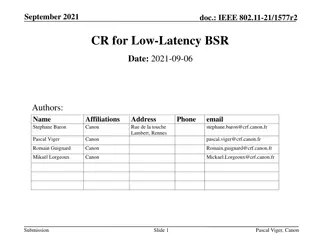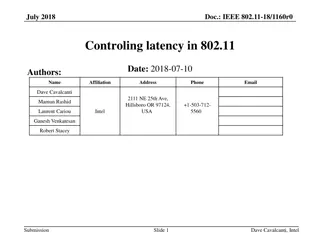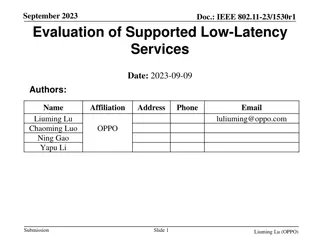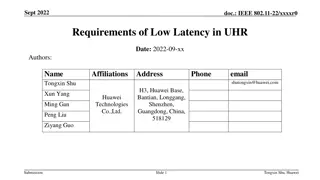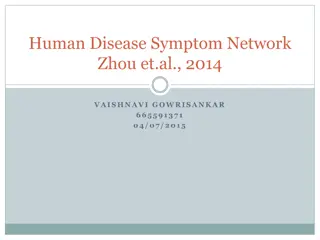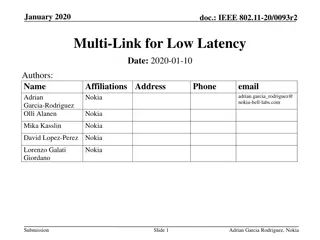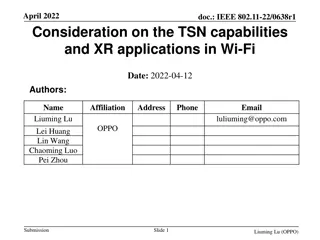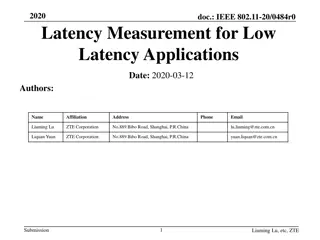Herpesviruses: Structure, Latency, and Disease
Herpesviruses, including HSV types 1 and 2, VZV, CMV, and EBV, exhibit unique characteristics in terms of structure, latency, and disease manifestations. These enveloped DNA viruses can establish latent infections, leading to recurrent diseases upon reactivation. Different herpesviruses infect various cell types and tissues, causing conditions like gingivostomatitis, vesicular rashes, and even cancer. Understanding the different types of herpesviruses and their behaviors is crucial for effective management and treatment.
Download Presentation

Please find below an Image/Link to download the presentation.
The content on the website is provided AS IS for your information and personal use only. It may not be sold, licensed, or shared on other websites without obtaining consent from the author.If you encounter any issues during the download, it is possible that the publisher has removed the file from their server.
You are allowed to download the files provided on this website for personal or commercial use, subject to the condition that they are used lawfully. All files are the property of their respective owners.
The content on the website is provided AS IS for your information and personal use only. It may not be sold, licensed, or shared on other websites without obtaining consent from the author.
E N D
Presentation Transcript
L:11 Virology By Prof.Dr . Nada Khazal K. Hindi
Enveloped DNA Viruses All herpesviruses can undergo an alternative infection cycle, entering a quiescent state (latency) cytocidal infection occurs from which they subsequently can be reactivated. Because the mechanism of latency is reactivation or recurrent disease are characteristic for each of the herpesviruses. The herpesvirus family contains eight important human pathogens: 1. herpes simplex virus types 1 2. herpes simplex virus types 2 3. varicella-zoster virus 4. HumanCytomegalovirus (HCMV). 5.Epstein Barr virus, Herpesvirus Types 6 and 7, 6. human herpesvirus 8 (the cause of Kaposi s sarcoma). -Some information is available regarding the mechanism by which herpes simplex virus (HSV) and cytomegalovirus (CMV) initiate and maintain the latent state. Shortly after HSV infects neurons, a set of latency-associated transcripts (LATS) are synthesized.
General structure of virus : *All herpesviruses are structurally similar. Each has an capsid surrounded by a lipoprotein enveloped . The genome is linear double-stranded DNA (dsDNA).The virion does not contain a polymerase. *They replicate in the nucleus, form intranuclear inclusions, and are the only viruses that obtain their envelope by budding from the nuclear membrane. *The virions of herpesviruses possess a tegument located between the nucleocapsid and the envelope. Herpesviruses are noted for their ability to cause latent infections. In these infections, the acute disease is followed by an asymptomatic period during which the virus remains in a quiescent (latent state). When the patient is exposed to an inciting agent or immunosuppression occurs, reactivation of virus replication and disease can occur. ***Three of the Herpesviruses, types 1(HSV-1) , Herpesviruses, types 2 (HSV-2) and Varicella-zoster virus (VZV), cause a vesicular rash, both in primary infections and in reactivations. Primary infections are usually more severe than reactivations. icosahedral ****Four herpesviruses, namely HSV types 1 and 2, VZV, and CMV, induce the formation of multinucleated giant cells, which can be seen microscopically in the lesions. -The importance of giant cells is best illustrated by the Tzanck smear, which reveals multinucleated giant cells in a smear taken from the painful vesicles of the genitals caused by HSV type 2 .
Types od HSV based on: 1) the type of cell most often infected. 2) the site of latency. -The alpha herpesviruses, consisting of HSV types 1 and 2 and VZV, infect epithelial cells primarily and cause latent infection in neurons. -The beta herpesviruses, consisting of CMVs and human herpesvirus 6, infect and become latent in a variety of tissues. -The gamma herpesviruses, consisting of EBV and human herpesvirus 8, infect and become latent primarily in lymphoid cells. ***Certain herpesviruses are associated with or cause cancer in humans (e.g.:Epstein Barr virus (EBV) is associated with Burkitt s lymphoma and nasopharyngeal carcinoma, ****human herpesvirus 8 causes Kaposi s sarcoma
Herpes Simplex Viruses (HSV) ***HSV type 1 (HSV-1) and type 2 (HSV-2) are distinguished by two main criteria: antigenicity and location of lesions: Lesions caused by HSV-1,2. Diseases: ***HSV-1 causes acute gingivostomatitis, recurrent herpes labialis (cold sores), keratoconjunctivitis (keratitis), and encephalitis, primarily in adults. (HSV-1 causes infection in upper body) ****HSV-2 causes herpes genitalis (genital herpes), neonatal encephalitis, other forms of neonatal herpes, and aseptic meningitis. **Infection by HSV-1 or HSV-2 is a common cause of erythema multiform. (HSV-2 causes infection in lower body)
Transmission of HSV-1, HSV-2: ***HSV-1 is transmitted primarily in saliva: HSV-1 infections occur mainly on the face ***HSV-2 is transmitted by sexual contact. HSV-2 lesions occur in the genital area. -However, oral genital sexual practices can result in HSV-1 infections of the genitals and HSV-2 lesions in the oral cavity (this occurs in about 10% 20% of cases). -Although transmission occurs most often when active lesions are present, asymptomatic shedding of both HSV-1 and HSV-2 does occur and plays an important role in transmission. -Most primary infections by HSV-1 occur in childhood, as evidenced by the early appearance of antibody.
Clinical Findings:HSV-1causes several forms of primary and recurrent disease: (1) Gingivostomatitis occurs primarily in children and is characterized by fever, irritability, and vesicular lesions in the mouth. The primary disease is more severe and lasts longer than recurrences. The lesions heal spontaneously in 2 to 3 weeks. Many children have asymptomatic primary infections. (2) **Herpes labialis (fever blisters or cold sores) is the milder, recurrent form and is characterized by crops of vesicles, usually at the mucocutaneous junction of the lips or nose. Recurrences frequently reappear at the same site. (3) Keratoconjunctivitis is characterized by corneal ulcers and lesions of the conjunctival epithelium. Recurrences can lead to scarring and blindness. (4) Encephalitis caused by HSV-1 is characterized by a necrotic lesion in one temporal lobe. Fever, headache, vomiting, seizures, and altered mental status are typical clinical features. The onset may be acute or protracted over several days. The disease occurs as a result of either a primary infection or a recurrence.
-HSV-2 causes several diseases, both primary and recurrent: 2) ****Genital herpes is characterized by painful vesicular lesions of the male and female genitals and anal area. Primary infections are associated with fever and inguinal adenopathy. -The lesions are more severe and protracted in primary disease than in recurrences. Asymptomatic infections occur in both men (in the prostate or urethra) and women (in the cervix) and can be a source of infection of other individuals. Many infections are asymptomatic *Approximately 80% to 90% of herpes genitalis cases are caused by HSV-2. The remainder are caused by HSV-1 as a result of oral genital contact.
(2) Neonatal herpes originates chiefly from contact with vesicular lesions within the birth canal. -Neonatal herpes varies from severe disease (e.g., disseminated lesions or encephalitis) to milder local lesions (skin, eye, mouth) to asymptomatic infection. *** Neonatal herpes disease may be prevented by performing cesarean section on women with either active lesions or positive viral cultures. - Both HSV-1 and HSV-2 can cause severe neonatal infections that are acquired after birth from carriers handling the child. **Serious neonatal infection is more likely to occur when the mother is experiencing a primary herpes infection than a recurrent infection for two reasons: **(1) the amount of virus produced during a primary infection is greater than during a secondary infection, **(2) mothers who have been previously infected can pass IgG across the placenta, which can protect the neonate from serious disseminated infection. **(3) Aseptic meningitis caused by HSV-2 is usually a mild
*Both HSV-1 and HSV-2 infections are associated with erythema multiforme. The rash of erythema multiforme appears as a central red area surrounded by a ring of normal skin outside of which is a red ring ( target or bull s eye lesion). The lesions are typically macular or papular and occur symmetrically on the trunk, hands, and feet. The rash is thought to be an immune- mediated reaction to the presence of HSV antigens. Prevention -Valacyclovir (Valtrex) and famciclovir (Famvir) are used in the suppression of recurrent lesions, especially in those with frequent recurrences caused by HSV-2. -Suppressive chemoprophylaxis also reduces shedding of the virus and, as a result, transmission to others. ***avoiding contact with the vesicular lesion or ulcer. *****Cesarean section is recommended to prevent HSV infection for women who are at term and who have genital lesions or positive viral cultures.
Reactivation of HSV: Several factors, such as hormonal changes, fever, and physical damage to the neurons, are known to induce reactivation and replication of the latent virus. The newly synthesized virions are transported down the axon to the nerve endings from which the virus is released, infecting the adjoining epithelial cells. Characteristic lesions are thus produced in the same general area as the primary lesions. [Note: Virus replication occurs in only a fraction of the latently infected neurons, and these nerve cells eventually die.] The presence of circulating antibody does not prevent this recurrence, but does limit the spread of virus to surrounding tissue. Sensory nerve symptoms, such as pain and tingling, often precede and accompany the appearance of lesions. In general, the severity of any systemic symptoms is considerably less than that of a primary infection, and many recurrences, in fact, are characterized by shedding of infectious virus in the absence of visible lesions.
HSV-1: The frequency of oropharyngeal symptomatic recurrences is variable, ranging from none to several a years. The lesions occur as clusters of vesicles at the border of the lips (herpes labialis or cold sores, fever blisters) and heal without scarring in eight to ten days. HSV-2: Reactivation of HSV-2 genital infections can occur with considerably greater frequency (for example, monthly) and is often asymptomatic, but still results in viral shedding. Consequently, sexual partners or newborn infants may be at increased risk of becoming infected resulting from lack of precautions against transmission. The risk of transmission to the newborn is much less than in a primary infection because considerably less virus is shed and there is maternal anti- HSV antibody in the baby.
Human Herpes Virus Type 6 (HHV-6): *primary infection is the cause of the common childhood illness exanthema subitum (also known as Roseola infantum or sixth disease). It is passed from child to child )by kindergarten( and once contracted, immunity arises and prevents future reinfection. HHV-6 reactivation is common in transplant recipients, which can cause encephalitis, bone marrow suppression, and pneumonitis. Transmission of Human Herpes Virus Type 6:- *Exanthem subitum occurs in children aged 6 months to 4 years of age. The disease is benign and is characterized by a high fever and a rash. Because the virus is found in the saliva of more than 90% of all adults, this saliva probably serves as the primary source of transmission. Human Herpes 8 (HHV-8)(Kaposi s Sarcoma Assosiated Herpes Virus):- *HHV-8, or Kaposi s sarcoma associated herpesvirus (KSHV), causes Kaposi s sarcoma (KS), the most common cancer in patients with AIDS. **Transmission of HHV-8 occurs primarily via sex and by saliva, but it is also transmitted in transplanted organs such as kidneys and appears to be the cause of transplantation-associated KS. The DNA of HHV-8 is found in the cells of transplantation-associated KS but not in the cells of other transplantation- associated cancers.
CYTOMEGALOVIRUS (CMV): *CMV causes cytomegalic inclusion disease (especially congenital abnormalities) in neonates. It is the most common cause of congenital abnormalities. CMV is a very important cause of pneumonia and other diseases in immunocompromised patients such as recipients of bone marrow and solid organ transplants. Important Properties **CMV is structurally and morphologically similar to other herpesviruses but is antigenically different. It has a single serotype. Humans are the natural hosts for CMV. Giant cells are formed, hence the name cytomegalo. Symptom: Infections of children and adults are usually asymptomatic, except in immunocompromised individuals. CMV enters a latent state primarily in monocytes and can be reactivated CMV can also persist in kidneys for years. Reactivation of CMV from the latent state in cervical cells can result in infection of the newborn during passage through the birth canal.
Transmission: **across the placenta, within the birth canal, **by saliva in young children, its most common mode of transmission. **sexually; it is present in both semen and cervical secretions. **blood transfusions and **organ transplants. ** any body fluids can be transmitted CMV ** virus is present in breast milk & neonates can be infected by this route CMV infection occurs worldwide, HCMV can also cross the placenta and infect a fetus in utero. Initial replication of the virus in epithelial cells of the respiratory and gastrointestinal (GI) tracts is followed by viremia and infection of all organs of the body. In symptomatic cases, kidney tubule epithelium, liver, and CNS, in addition to the respiratory and GI tracts, are most commonly affected. animal CMV strains do not infect humans. CMV infection causes an immunosuppressive effect by inhibiting T cells.
Clinical Findings ****Approximately 20% of infants infected with CMV during gestation show clinically apparent manifestations of cytomegalic inclusion disease such as microcephaly, seizures, deafness, jaundice, and purpura. The ****purpuric lesions resemble a blueberry muffin and are due to thrombocytopenia. *Hepatosplenomegaly is very common. In immunocompetent adults *Heterophil-negative mononucleosis, which is characterized by fever, lethargy, and the presence of abnormal lymphocytes in peripheral blood smears. -Systemic CMV infections, especially pneumonitis,esophagitis, and hepatitis, occur in a high proportion of immunosuppressed individuals (e.g., those with renal and bone marrow transplants). Latency and reactivation: A distinctive feature of HCMV latency is the phenomenon of repeated episodes of asymptomatic virus shedding over prolonged periods. Latency is probably established in monocytes and macrophages, but other cell types, such as those of the kidney. Persistent fever, muscle pain, and lymphadenopathy & elevated levels of abnormal lymphocytes and liver enzymes. Two specific situations have greater clinical significance, congenital infections and infection of immunocompromised patients.
Congenital infections: HCMV is the most common intrauterine viral infection. However, there is a great disparity in incidence of fetal infection and severity of outcome, depending on whether the mother is experiencing a primary or recurrent infection. The severity of the symptoms is most infection occurs during the first trimester. Referred to as cytomegalic inclusion disease, results caused by the infection range from fetal death to various degrees of damage to liver, spleen, blood-forming organs, and components of the nervous system. The latter is a common cause of hearing loss and mental retardation. Even in infants who are asymptomatic at birth, hearing deficits and ocular damage (for example, chorioretinitis) may appear later and continue to progress during the first few years.









